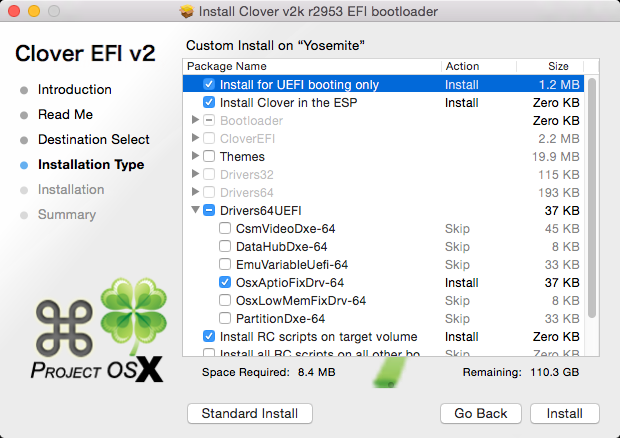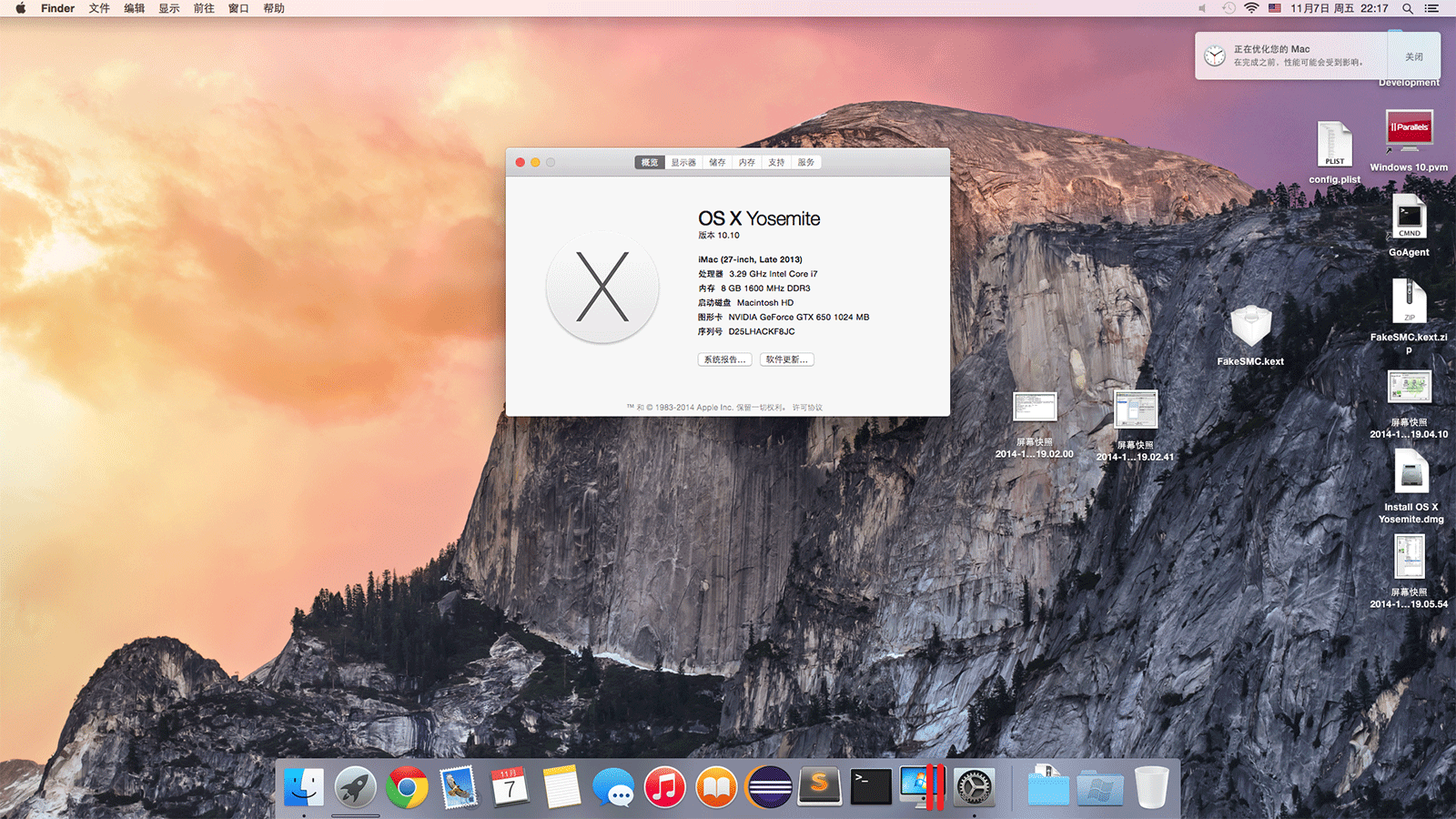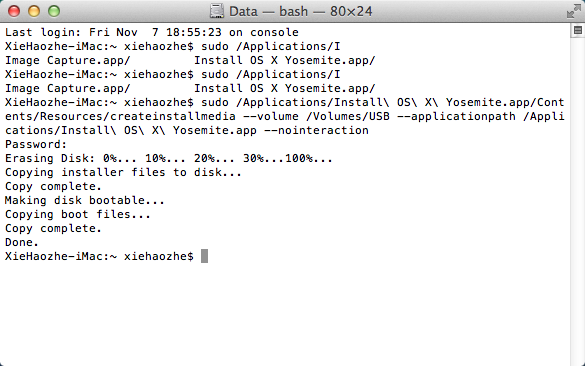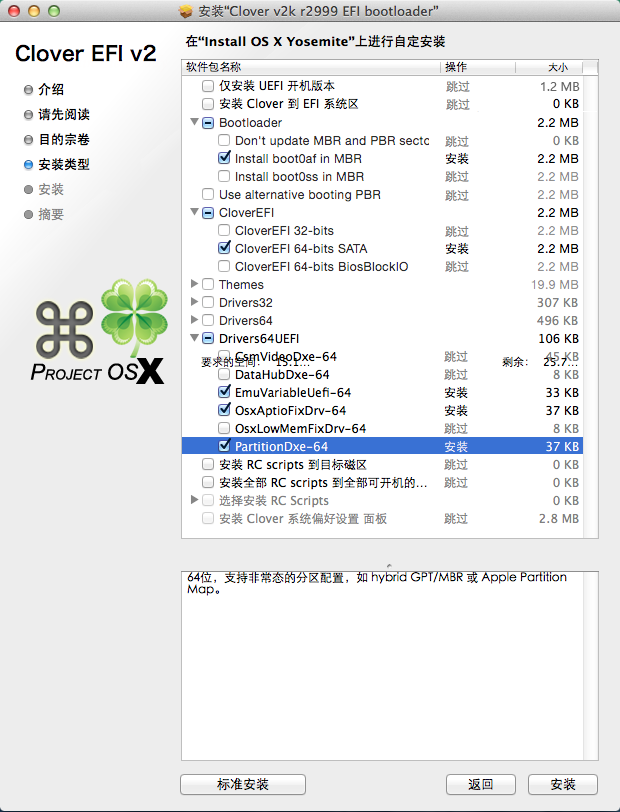Clover is a new and exciting open source EFI bootloader. Developed over the past 3 years by a group of developers at Project OS X led by Slice, Clover aims to solve problems inherent in existing OS X installation methods and legacy bootloaders:
- Boots troublesome desktop and laptop BIOS/UEFI
- Uses native OS X installation media
- Ability to patch DSDT/kernel/kexts at boot time
- Creates OS X Recovery partition
- No boot0 error with 4K Advanced Format drives
- Solves multi-boot issues with Linux and Windows 7/8
- Solves traditional bootloader NVRAM issues related to iMessage/FaceTime
Clover has a completely different system of configuration with a decidedly steep learning curve. It can be confusing for those who have only ever used the more traditional Chameleon or Chimera.
Clover is also in beta stage, and is not guaranteed to work well for all systems. Development has been fast and furious, with many major changes appearing in the code all the time. Clover can be a moving target, difficult to pin down- almost, it seems, by design. Recent changes, however, have stabilized things enough to be a reliable alternative for those adventurous enough to learn something new.
Overview
- Download the OS X Yosemite Application from the Mac App Store
- Prepare a USB flash drive as Installer
- Install OS X Yosemite
- Install the bootloader and drivers to system drive
Download OS X Yosemite
The full operating system is a free download for anyone who has purchased Mac OS X Snow Leopard, Lion, or Mountain Lion. Download the Application from the Mac App Store using your Apple ID on any Mac or functional computer running Mac OS X 10.6.8 or later.
- Open Mac App Store
- Log in with your Apple ID
- Download OS X Yosemite
The Application Install OS X Yosemite will appear in /Applications.
Prepare a USB Flash Drive as Installer
This step extracts the OS X Installer contents, then installs Clover bootloader to the USB stick.
3.1. Insert the USB drive
3.2. Open /Applications/Utilities/Disk Utility
3.3. Highlight the USB drive in left column
3.4. Click on the Partition tab
3.5. Click Current and choose 1 Partition
3.6. Click Options…
3.7. Choose **GUID Partition Table
** 8. Under Name: type USB (You can rename it later)
3.9. Under Format: choose Mac OS Extended (Journaled)
3.10. Click Apply then Partition
3.11. Open /Applications/Utilities/Terminal
3.12. Type the following, enter password and hit enter. This command completely erases the USB, then creates native OS X installer media from the Install OS X Yosemite Application.
sudo newfs_msdos -v EFI -F 32 /dev/rdisk0s1
- Download the latest version of Clover from sourceforge
- Install Clover to Yosemite with the following Custom settings:
These settings will install the bootloader to the system drive’s EFI partition automatically as part of the scripting. After completion, the system drive’s EFI partition will automatically mount.
A few more changes need to be made to the default Clover installation:
- Navigate to /Volumes/EFI/EFI/CLOVER/ and edit config.plist
- Navigate to /Volumes/EFI/EFI/CLOVER/kexts/ and create a folder called 10.10
- Navigate to /Volumes/EFI/EFI/CLOVER/kexts/10.10/ and add **FakeSMC.kext
** 8. Navigate to /Volumes/EFI/EFI/CLOVER/kexts/10.10/ and add your ethernet kext - (Optional) Navigate to /Volumes/EFI/EFI/CLOVER/ACPI/patched/ and add DSDT.aml and**SSDT.aml
**
See attached config.plist for a working minimal configuration. For more details and documentation navigate to /EFI/CLOVER/doc. To help navigate the config.plist and add a system definition, check outClover Configurator. For a GUI to mount/unmount EFI partition, see EFI Mounter v2.
You’ve reached the end of the universal setup guide. If you have issues, please leave a message at the end of the page. Special thanks to toleda and Going Bald for their testing and comments during the making of this guide. Good luck!
Reference
- http://www.tonymacx86.com/mavericks-desktop-guides/125632-how-install-os-x-mavericks-using-clover.html
- http://www.tonymacx86.com/mavericks-desktop-guides/144426-how-install-os-x-yosemite-using-clover.html
sudo /Applications/Install\ OS\ X\ Yosemite.app/Contents/Resources/createinstallmedia --volume /Volumes/USB --applicationpath /Applications/Install\ OS\ X\ Yosemite.app --no interaction
Upon completion, the USB will be renamed Install OS X Yosemite.
- Download the latest version of Clover from Sourceforge
- Open Clover package installer
- Hit Continue, Continue, Change Install Location…
- Choose the USB, now called Install OS X Yosemite
- Hit Customize and install Clover to the same USB with the following Custom Install settings:
NOTE: There are a few different ways to setup Clover on the USB. Using Legacy Mode is the simplest and most reliable for 5, 6, 7, and 8 series Gigabyte motherboards with standard default BIOS or UEFI settings. For all other UEFI-based systems such as Asus 7 and 8 series motherboards, use UEFI Boot Mode to install to the EFI partition of the USB for UEFI booting only.
A few more changes need to be made to the default Clover installation:
- Navigate to /EFI/CLOVER/ and replace default config.plist with attached *config.plist
** 21. Navigate to /EFI/CLOVER/kexts/ and create a folder called 10.10 - Navigate to /EFI/CLOVER/kexts/10.10/ and add **FakeSMC.kext
** 23. Navigate to /EFI/CLOVER/kexts/10.10/ and add your ethernet kext - Navigate to /EFI/CLOVER/kexts/10.10/ and add NullCPUPowerManagement.kext
- Navigate to /EFI/CLOVER/drivers64UEFI/ remove VBoxHfs-64.efi and add HFSPlus.efi
- (Optional) Navigate to /EFI/CLOVER/ACPI/patched/ and add DSDT.aml and **SSDT.aml
**
*See attached config.plist for a working minimal configuration.
Install OS X Yosemite
Unlike UniBeast, this is a 3 part installation process. The system will reboot twice in order to finish the installation and the recovery partition.
- Turn on the computer
- Press the hotkey to choose boot device
- Choose USB
If using a USB 3.0 port, the boot manager screen may appear, at which point proceed with steps a-b.
a. Choose Boot Manager
b. Choose EFI USB Device
- When Clover boot screen is visible, choose Boot OS X Install from OS X Install OS X Yosemite
- The system will then boot into OS X Installer
- For a new installation of OS X, you MUST erase and format the destination drive according to the following steps before continuing. If you are upgrading from Snow Leopard, Lion, or Mountain Lion and you want to keep your files and apps, skip steps a-j.
a. Choose Disk Utility
b. Highlight your target hard drive for the Yosemite installation in left column.
c. Click Partition tab
d. Click Current and choose 1 Partition
e. Click Options…
f. Choose GUID Partition Table
g. Under Name: type Yosemite (You can rename it later)
h. Under Format: choose Mac OS Extended (Journaled)
i. Click Apply then Partition
j. Close Disk Utility
- When the installer asks you where to install, choose Yosemite, or your existing install.
- Upon completion, system will restart a 1st time
- Press the hotkey to choose boot device
- Choose USB
- When Clover boot screen is visible, choose Boot OS X Install from OS X Install OS X Yosemite
The system will boot into the new drive, create the recovery partition, and complete the installation. Upon completion, system will restart a 2nd time.
- Press the hotkey to choose boot device
- When Clover boot screen is visible, choose **Yosemite
** 14. The system will launch OS X Setup
Install the Bootloader and Drivers to System Driver
At this point, the easiest way to proceed is to install the bootloader, grab backups from the root of your USB drive, and copy the files that worked directly to the system drive’s EFI partition. However, getting post-installation 100% right for your system is something that needs to be done on a case by case basis. No single Clover setup will work perfectly for every system. For best compatibility, it is recommended that the EFI partition also be reformatted to FAT32 instead of default HFS.
- Open /Applications/Utilities/Terminal
- Type: diskutil list and locate your system drive’s EFI partition. It will be under IDENTIFIER. Be sure to use the correct one. (For this example: disk0s1)
- Type the following, enter password and hit enter:
sudo newfs_msdos -v EFI -F 32 /dev/rdisk0s1
- Download the latest version of Clover from sourceforge
- Install Clover to Yosemite with the following Custom settings:
These settings will install the bootloader to the system drive’s EFI partition automatically as part of the scripting. After completion, the system drive’s EFI partition will automatically mount.
A few more changes need to be made to the default Clover installation:
- Navigate to /Volumes/EFI/EFI/CLOVER/ and edit config.plist
- Navigate to /Volumes/EFI/EFI/CLOVER/kexts/ and create a folder called 10.10
- Navigate to /Volumes/EFI/EFI/CLOVER/kexts/10.10/ and add **FakeSMC.kext
** 8. Navigate to /Volumes/EFI/EFI/CLOVER/kexts/10.10/ and add your ethernet kext - (Optional) Navigate to /Volumes/EFI/EFI/CLOVER/ACPI/patched/ and add DSDT.aml and**SSDT.aml
**
See attached config.plist for a working minimal configuration. For more details and documentation navigate to /EFI/CLOVER/doc. To help navigate the config.plist and add a system definition, check outClover Configurator. For a GUI to mount/unmount EFI partition, see EFI Mounter v2.
You’ve reached the end of the universal setup guide. If you have issues, please leave a message at the end of the page. Special thanks to toleda and Going Bald for their testing and comments during the making of this guide. Good luck!





The Disqus comment system is loading ...
If the message does not appear, please check your Disqus configuration.